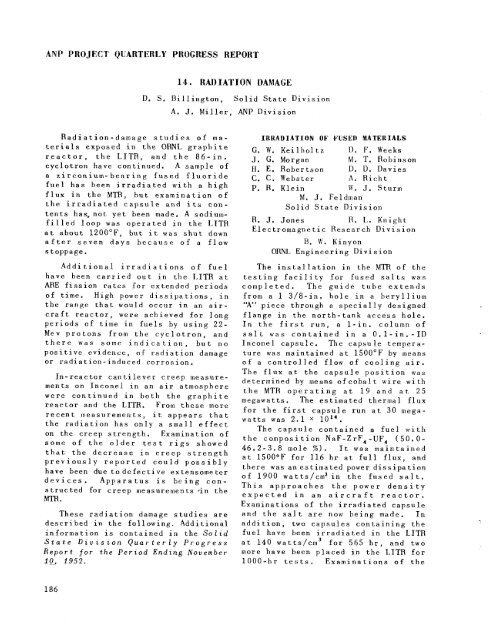the Molten Salt Energy Technologies Web Site
the Molten Salt Energy Technologies Web Site
the Molten Salt Energy Technologies Web Site
Create successful ePaper yourself
Turn your PDF publications into a flip-book with our unique Google optimized e-Paper software.
ANP PROJECT QUARTERLY PROGRESS REPORT<br />
14. RADIATION DAMAGE<br />
D. S. Billington, Solid State Division<br />
A. J. Miller,<br />
Radiation-damage studies of ma-<br />
terials exposed in <strong>the</strong> ORNE graphite<br />
reactor, <strong>the</strong> LITR, and <strong>the</strong> 86-in.<br />
cyclotron have continued. A sample of<br />
a zirconium-bearing fused fluoride<br />
fuel has been irradiated with a high<br />
flux in <strong>the</strong> MTR, but examination of<br />
<strong>the</strong> irradiated capsule and its con-<br />
tents has, not yet been made. A sodium-<br />
filled loop was operated in <strong>the</strong> LITR<br />
at about 1200”F, but it was shut down<br />
after seven days because of a flow<br />
s t oppage .<br />
Additional irradiations of fuel<br />
have been carried out in <strong>the</strong> LITR at<br />
ARE fission rates for extended periods<br />
of time. High power dissipations, in<br />
<strong>the</strong> range that would occur in an air-<br />
craft reactor, were achieved for long<br />
periods of time in fuels by using 22-<br />
Mev protons from <strong>the</strong> cyclotron, and<br />
<strong>the</strong>re was some indication, but no<br />
positive evidence, of radiation damage<br />
or radiation-induced corrosion.<br />
In-reactor cantilever creep measure-<br />
ments on Inconel in an air atmosphere<br />
were continued in both <strong>the</strong> graphite<br />
reactor and <strong>the</strong> LITR. Frorn <strong>the</strong>se more<br />
recent measurements, it appears that<br />
<strong>the</strong> radiation has only a small effect<br />
on <strong>the</strong> creep strength. Examination of<br />
some of <strong>the</strong> older test rigs showed<br />
that <strong>the</strong> decrease in creep strength<br />
previous 1 y reported cou Id pos s i bl y<br />
have been due to defective extensometer<br />
devi.ces. Apparatus is being con-<br />
structed for creep measuremenLs #in <strong>the</strong><br />
MTR.<br />
These radiation damage studies are<br />
described in <strong>the</strong> following. Additional<br />
information is contained in <strong>the</strong> So 1 id<br />
State Division Quarterly Progress<br />
Report for <strong>the</strong> Period Ending November<br />
lo-, 1952.<br />
186<br />
ANP Dhvision<br />
IRRADIATION OF FUSED HATERIALS<br />
G. W. Keillioltz D. F. Weeks<br />
J. G. Morgan M. T. Robinson<br />
11. E. Robertson D. D. Davies<br />
C. C. <strong>Web</strong>ster A. Richt<br />
P. R. Klein W. J. Sturm<br />
M. J. Feldman<br />
Solid State Division<br />
R. J. Jones R. I,. Knight<br />
Electromagnetic Research Division<br />
B. 1‘. Kinyon<br />
OHNL Engineering Division<br />
The installation in <strong>the</strong> MTR of <strong>the</strong><br />
testing facility for fused salts was<br />
completed. The guide tube extends<br />
from a 1 3/8-in. hole in a beryllium<br />
“A” piece through a specially designed<br />
flange in <strong>the</strong> north-tank access hole.<br />
In <strong>the</strong> first run, a 1-in. column of<br />
salt was contained in a 0.1-in.-ID<br />
Inconel capsule. The capsule ternpcra-<br />
ture was maintained at 1500°F by means<br />
of a controlled flow of cooling air.<br />
The flux at <strong>the</strong> capsule position was<br />
determined by means of cobal t wire with<br />
<strong>the</strong> MTR operating at 19 and at, 25<br />
megawatts. The estimated <strong>the</strong>rmal flux<br />
for <strong>the</strong> first capsule run at 30 mega-<br />
watts was 2.1 x ioi4.<br />
The capsule contained a fuel with<br />
<strong>the</strong> composi tion NaF-ZrF4 -UF, (50.0-<br />
46.2-3.8 mole X). It was maintained<br />
at 1500°F for 116 hr at full flux, and<br />
<strong>the</strong>re was an estimated power dissipation<br />
of 1900 watts/cm3 in <strong>the</strong> fused salt.<br />
This approaches <strong>the</strong> power density<br />
expected in an aircraft reactor,<br />
Examinations of <strong>the</strong> irradiated capsule<br />
and <strong>the</strong> salt are now being made. In<br />
addition, two capsules containing <strong>the</strong><br />
fuel have been irradiated in <strong>the</strong> LITR<br />
at 140 watts/cm3 for 565 hr, and two<br />
more have been placed in <strong>the</strong> LITR for<br />
1000-hr tests. Examinations of <strong>the</strong>



![Review of Molten Salt Reactor Physics Calculations [Disc 2]](https://img.yumpu.com/21979492/1/190x247/review-of-molten-salt-reactor-physics-calculations-disc-2.jpg?quality=85)












